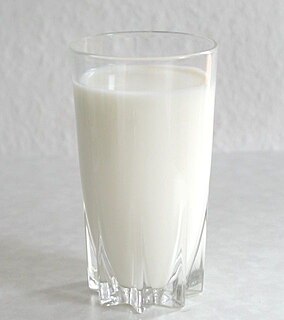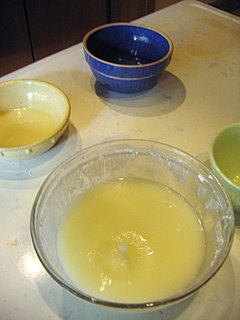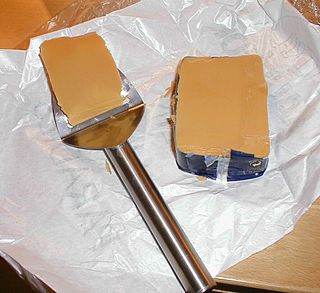
Dairy products, milk products or lacticinia are a type of food produced from or containing the milk of mammals, primarily cattle, water buffaloes, goats, sheep, camels, and humans. Dairy products include food items such as yogurt, cheese, and butter. A facility that produces dairy products is known as a dairy, or dairy factory. Dairy products are consumed worldwide, with the exception of much of East and Southeast Asia and also some parts of central Africa.

Mozzarella is a traditionally southern Italian cheese made from Italian buffalo's milk by the pasta filata method. Mozzarella received a Traditional Specialities Guaranteed certification from the European Union in 1998. This protection scheme requires that mozzarella sold in the European Union is produced according to a traditional recipe.

Whey is the liquid remaining after milk has been curdled and strained. It is a byproduct of the manufacture of cheese or casein and has several commercial uses. Sweet whey is a byproduct produced during the manufacture of rennet types of hard cheese, like Cheddar or Swiss cheese. Acid whey is a byproduct produced during the making of acid types of dairy products, such as cottage cheese or strained yogurt.

Mizithra or myzithra is a fresh cheese made with milk and whey from sheep or goats, or both. The ratio of milk to whey usually is 7 to 3. Production resembles that of Italian ricotta. Furthermore, Mizithra can be salt-dried to produce a mature salty cheese similar to the Italian ricotta salata.

Goat cheese, goats' cheese, or chèvre, is cheese made from goat's milk.

Ricotta is an Italian whey cheese made from sheep, cow, goat, or Italian water buffalo milk whey left over from the production of other cheeses. Like other whey cheeses, it is made by coagulating the proteins that remain after the casein has been used to make cheese, notably albumin and globulin.

Cheesemaking is the craft of making cheese. The production of cheese, like many other food preservation processes, allows the nutritional and economic value of a food material, in this case milk, to be preserved in concentrated form. Cheesemaking allows the production of the cheese with diverse flavors and consistencies.

Havarti or cream Havarti is a semisoft Danish cow's milk cheese. It is a table cheese that can be sliced, grilled, or melted.

Comté is a French cheese made from unpasteurized cow's milk in the Franche-Comté traditional province of eastern France. Comté has the highest production of all French AOC cheeses, at around 64,000 tonnes annually.
White cheese may refer to:

Strained yogurt, Greek yogurt, yogurt cheese, or sack yoghurt is yogurt that has been strained to remove most of its whey, resulting in a thicker consistency than unstrained yogurt, while preserving yogurt's distinctive sour taste. Like many types of yogurt, strained yogurt is often made from milk that has been enriched by boiling off some of its water content, or by adding extra butterfat and powdered milk. In Europe and North America, it is often made from low-fat or fat-free milk. In Iceland, a similar product named skyr is made.

Cheese is a dairy product derived from milk that is produced in a wide range of flavors, textures, and forms by coagulation of the milk protein casein. It comprises proteins and fat from milk, usually the milk of cows, buffalo, goats, or sheep. During production, the milk is usually acidified, and adding the enzyme rennet causes coagulation. The solids are separated and pressed into final form. Some cheeses have molds on the rind, the outer layer, or throughout. Most cheeses melt at cooking temperature.
Primost is a Norwegian cheese made from cow's milk which has a soft spreadable texture providing a semi-sweet taste. The sweetness is derived from caramelizing the milk sugars of the whey as it is made. It is also known as mysost.

Caprino is an Italian cheese traditionally made from whole or skim goat's milk. The name of the cheese derives from the Italian word for goat, capra. With modern methods of production, the cheese is made from cow's milk, as well, or a combination of both cow's and goat's milks. The two major styles of caprino are fresco (fresh) and stagionato (aged).

Types of cheese are grouped or classified according to criteria such as length of fermentating, texture, methods of making, fat content, animal milk, country or region of origin, etc. The method most commonly and traditionally used is based on moisture content, which is then further narrowed down by fat content and curing or ripening methods. The criteria may either be used singly or in combination, with no single method being universally used.















